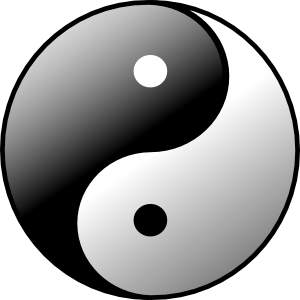“Absence, the highest form of presence.” ― James Joyce
You can't see the invisible.
You can't name the fugitive.
You can't hear what can't be heard.
You can't grasp what you can't touch.
Now can you?
You can't avoid these qualities, but you can't comprehend them, either.
They make a universe.
Tonight the sky is dark and the earth glows as with moonlight.
A cord stretches from it to it, and returns and returns.
What is the substance of emptiness, the form of the shapeless?
Confront it and its face evades you.
Follow it and its back disappears.
But still the ancients moved with the Tao into presence.
Stay connected to the origin.
That's Tao's cord.
Tzu, Lao. Waterway: a new translation of the Tao Te Ching (chapter 14) and introducing the Wu Wei Ching (Kindle Locations 175-184). crispy press. Kindle Edition.
Double Whip - Exposition of the Mystery
In weeks three and four we only learn one new posture ( Double Whip ). This is a posture/movement that can take quite a long time to master as it requires a simultaneous and subtle integration of multiple Tai Chi principles while stepping and turning the body through the better part of circle. Three years ago I posted on a philosophical connection I saw between the experience of this movement and an essay by Amanda Gefter concerning the Higgs Field ( here ) and I am borrowing some of my on text below.The most basic conceptual principle that is fundamental to Taoist philosophical thought can be described as 'complementary opposition' . This concept is represented by the well recognized tai chi diagram which models the interdependent relationship between yin and yang. Yin and yang can represent any pair of interdependent complementary opposites such as dark and light, form and formlessness, or, asymmetry and symmetry.

In line with the tai chi diagram, the Ni family harmony style tai chi movement form is composed of two sections: a 58 movement yin section, and a 50 movement yang section. Like the dark and light fish represented in the diagram, the yin and yang sections of the form asymmetrically oppose each other in such a way that their integration allows for the emergence of something greater than the parts. What emerges is symbolized by the symmetrical form of the circle, and what underlies the integration of the parts is a greater symmetry that could be said to be formless.
Consider the two postures 'double whip' and 'single whip'. Common to each of the postures is the underlying meaning 'exposition of the heavenly mystery'. An exposition is the setting forth of a theme. The 'double whip' posture serves this function for the yin section while it's opposing complement 'single whip' serves this function for the yang section. While each of these postures is composed of circular movements the 'double whip' is more contained, less expansive and turns 180 degrees from left to right. In contrast the 'single whip' is less contained, more expansive, and turns from right to left. Like the light dot contained within the dark fish the 'double whip' is said to represent 'yang contained within the yin'. Conversely, the 'single whip' represents the light fish which contains a darkened dot or 'yin within yang'. Together they complete the 360 degree circle of the tai chi diagram.
Moving From Absence Into Presence
Embracing emptiness, absence, mystery, uncertainty, and doubt are common theme's in Taoist philosophy. These ideas are not unique to Taoism. Just to give two examples, emptiness is central in Buddhist thought, and the poet Keats' concept of 'Negative Capability' also has a similar emphasis (1).'Several things dovetailed in my mind, & at once it struck me, what quality went to form a Man of Achievement especially in Literature & which Shakespeare possessed so enormously — I mean Negative Capability, that is when man is capable of being in uncertainties, Mysteries, doubts, without any irritable reaching after fact & reason'My interpretation of the Taoist idea of embracing absence does not require a negation of presence, and neither does the idea of 'being in uncertainties' require a rejection of 'facts & reason'. The ideal embodiment of absence reveals itself as presence. A mind aware of its own uncertainties is properly situated to evaluate facts, apply reason, and perhaps be surprised by new understandings.
There are many distinctions to keep track of while learning the 'Double Whip' movement. The rooted foot connecting one to the earth is constantly changing, the waist (lower dantian) is directing the movement, subtle circular expressions are unfolding out to the extremities, and all the while a visual panorama in flux is being received from above. Any focused attention revealing one of these aspects will conceal all the others. To bring them all into presence we must forget the particulars ( bring them into absence).
What is the substance of emptiness, the form of the shapeless?
Confront it and its face evades you.
Follow it and its back disappears.
But still the ancients moved with the Tao into presence.
Stay connected to the origin.
That's Tao's cord.